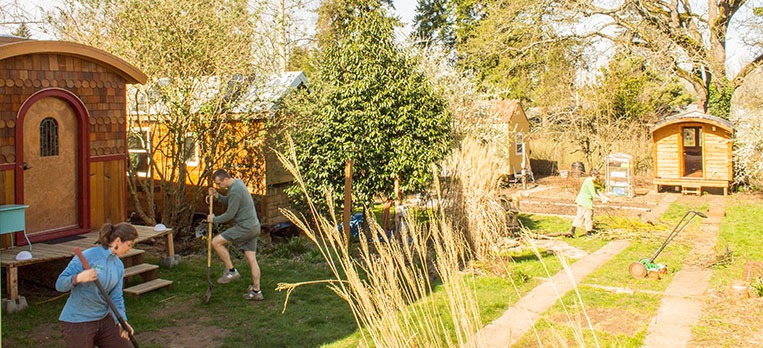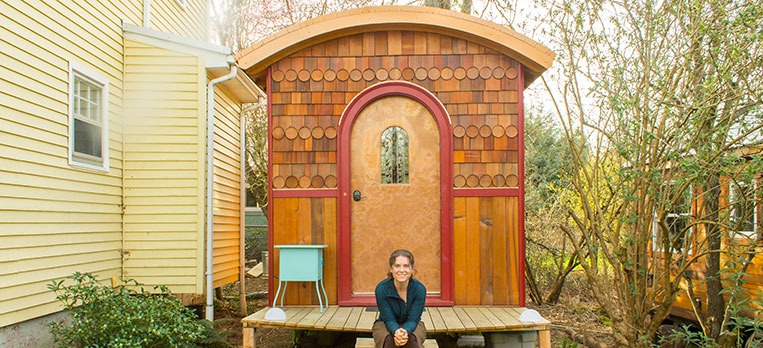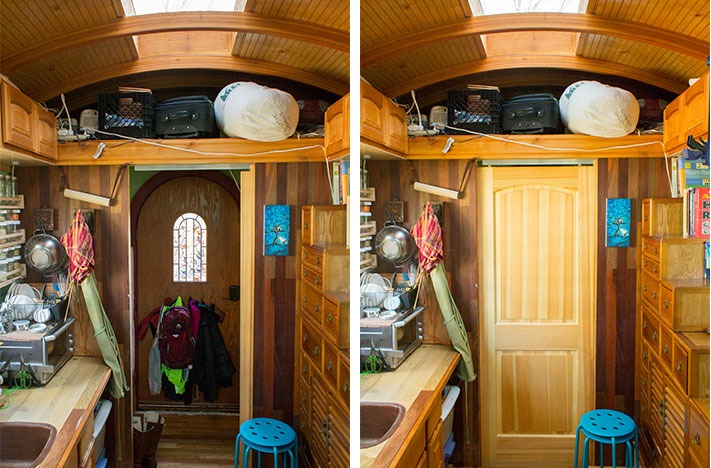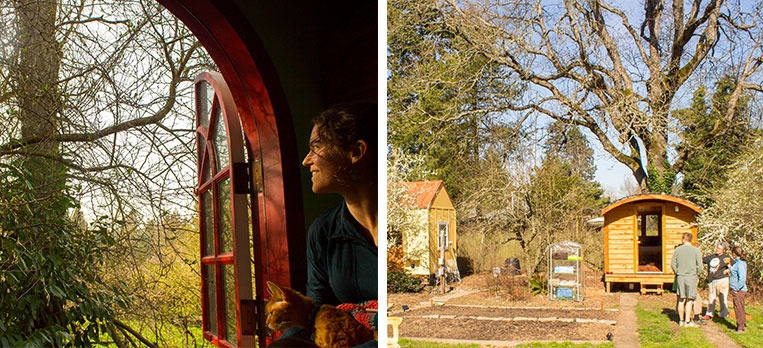
People often say they’d like to “start a tiny house community,” but what would that look like? What kind of “home” could balance your needs for independence and interaction with others? Lina Menard found her answers to those questions in the Simply Home Community.
Lina’s passion for housing and community building started young. She was 14 when she became fascinated with cohousing, a type of intentional community that blends privately owned homes with collaboratively-shared common spaces. In her early 20’s she discovered tiny houses and decided to build her own, but detoured through several rented small spaces first. She spent a couple years renting two different tiny houses on wheels and a yurt, all located in backyards around Portland, Oregon, where she experienced different ways spaces are shared or not shared, and how that affects whether the people in those spaces stand alone or are held by others.
A Different Model for Home
Lina’s involvement in the tiny house movement in Portland stretched through her academic studies, her professional paths as a tiny house designer and consultant, and her personal life, which included helping run a series of potlucks for tiny house enthusiasts. One of the group’s “subcommittees” investigated how to buy land to create a community of multiple tiny houses. One member of the group found an oversized lot with an existing home, and made an offer. When the time was finally right for Lina to build her own tiny house, the wheels of the Simply Home Community were in motion, and she hopped on board.
It’s not the typical “tiny house in a backyard” scenario, nor is it an “RV park for tiny houses.” Lina is part of a unique tiny house community modeled after cohousing designs: several tiny houses share a lot with a big house, but they also share the big house itself. Some people have “roomies”; Lina has “landies.”
I’m thrilled to share this first part of a two-part post about Lina’s unique story of her experience with the Simply Home Community, as well as some information about the zoning and legal rationale for the community. The group knows to expect the unexpected when you’re pioneering, but Lina is game to share what she can because, “Once you’ve fessed up to the Mayor, you get a little less scared about being bold.”
You can learn more about Lina at Niche Consulting or her personal blog covering years of interesting homes, This is The Little Life. You can find more personal stories of tiny house living in my ebook Life in a Tiny House.

Lina: “It’s amazing how often somebody says, “I’ve got this great idea! I want to have a tiny house, but have a bunch of them, and have them all together!” It’s really fun that so many people come up with this idea independently, and that there’s so much interest and enthusiasm around it.
A lot of people haven’t actually done it, though, because it’s hard enough to figure out where to put one tiny house. To try to figure out where to put a bunch of them is really a challenge. Not just in terms of the physical space, but the legality.
Simply Home Community is a piece of property that’s owned right now by a couple of individuals, but the intention is to shift ownership to the LLC [A multi-member Limited Liability Company made of most, but not all, members of the community]. It all got started because a group of us who were all tiny house enthusiasts wanted a place where we could all legally share space and resources. One of our subcommittees of that group looked into property. This small group became an offshoot of that, and ended up finding a piece of property and deciding to move forward with it.
There’s a big house, where we have three people living, and currently we also have a guest room. Everybody in the community has full access to the big house kitchen, dining room, living room, bathroom, and laundry. That works out really nicely because we can have game nights, we can host dinner parties, we can do movie nights, and when we do have guests, they can stay in the guest room.
Then we have four little houses on the property that are basically acting as “detached bedrooms” – a little space of our own. For instance, being able to use the bathroom in the big house means that I don’t have to have those facilities in my little house. Being able to cook a big meal for the community means that in my little house I can just make my breakfast, pack my lunch, and not have to do a big cooking event in here.
I really have the best of both worlds in terms of having my own space that is all mine, where I don’t share walls or have to worry about whether I’m going to disturb anybody if I turn the light on and read, but I get to have the benefits of having a bigger space. I hosted a dinner party for 10 in the big house a little bit ago, which was really fun. I couldn’t have done that in a tiny house.”

Community and Legality
Lina feels the cohousing element of the community may even strengthen their legal right to live there, because they operate like one large household. Feeling like they’re on decent legal footing is one asset of that, but the other is to experience the benefits of being part of a close community:
Lina: “What’s illegal is living in a non-habitable structure: tents, trailers, RVs, et cetera. I guess it’s kind of questionable whether you would say I “live” here or not. I do my bathing and toileting in the big house. I cook some of my meals in the big house, I make my tea and my toast and jam here. I sleep here. So where am I living? I’m living on the property. I’m living in the community. But I don’t do all my living inside this box.
I think that if we were each living independently… If the people in the big house were renting out spots and we never had any interaction with each other, or never had access to the big house, I think that’s actually when we’d have more trouble. But as it is, the little houses are kind of an extension of the house – the “detached bedrooms” that are associated with the big house.
We share a lot of responsibility. We share a lot of resources. We share some of our purchasing – we just started a list of things that we’re going to share in bulk. We have shared chores, we do work parties, we have house meetings. Half of our meetings are with regard to logistics and coordinating ourselves, and the other half are about getting to know each other better and care about each other more.
I wasn’t sure, after living alone for three years, that I would be able to live well in community. I was nervous about it. But it’s been really great. I’ve had some level of community everywhere I’ve been in town. It’s not like I’ve been totally isolated. During hard times, people have helped each other out in the other places I’ve lived too. I often have shared meals a little bit with other people, but it’s more intentional and consistent here, and that was something I had wanted.

A lot of the really good stuff of community is happening here. I have especially enjoyed our meals. I can cook a great big dinner one day a week, and come home to a nice, delicious dinner three or four days a week. That’s really sweet. [laughs] It’s nice just to be able to run errands together sometimes. There are times when somebody needs something and says, “Hey, I’m running to the hardware store, the grocery store, wherever,” and people pitch in and help each other out.
I wasn’t sure I would necessarily hang out with my landies as much as I do. I like them a whole awful lot, but I wasn’t really sure what our level of engagement would be. I didn’t know whether we would do game nights and movie nights. I didn’t know if we would be there for each other during hard times, or whether we’d rely on other friends for that. We’ve had some hard times amongst us already, and it’s been cool to see people rallying for each other. That has probably been my biggest surprise, that being part of this community has helped me settle in a little bit. To feel more at home in Portland.”
Making A Tiny House Community Work
While Simply Home is the first “tiny cohousing community” that Lina knows of, there are many ways to live in community with others. Lina has done academic work around nearly every version, and shared a primer on the different types of intentional communities, as well as what makes her specific community unique.
Lina: “Ecovillages, co-ops, communes and cohousing are all pretty distinctly different from one another, although people sometimes conflate them. In my mind, a commune is a pretty broad, collective ownership system. There’s this kind of, “We all together, as one, own things together, raise kids together.” Cohousing is kind of the opposite end of the spectrum, in that everyone owns their own home, but has an equal share in common facilities. In the middle are things like co-ops, where there’s shared space, but there’s a little more variety about how that sharing happens.
Cohousing residents are not necessarily sharing childcare or finances. I think of this as cohousing because it’s structured really similarly to how a lot of cohousing is: We all have a space of our own but we share extensive common facilities. Shared meals are something that’s common among intentional communities and that’s true here, too. At Simply Home we have four sets of homeowners on this property, and then a couple of people who are renters, but we’re all community members.
We’ve tried to decide how to articulate what community means to us… And we don’t have answers, you know. We’re still in the midst of these conversations. But we do have a set of community living agreements, and those are guiding a lot of our decision making.
In a tiny house community, I knew that there would be a certain set of values shared. What brought us together was pretty much tiny houses, which includes a lot of other things, right? It includes a certain amount of “do it yourself”-ness, a certain commitment to having a place of one’s own. For a lot of us, the environmental piece is part of it.
I feel really lucky that in our community there has been a shared commitment to sharing meals, to sharing work, and to sharing fun, because that’s really what makes community work.”
Engagement with the Greater Community
Years of study and real-life experience with different forms of housing and community have helped Lina become very thoughtful about how home supports what’s most important to her. One priority she’s articulated is that, for her, intentionality is more important than simplicity. And what she’s intentional about is connecting – both with people close to her, and with the people in her greater community. Making space for aspects of her life to happen in public creates opportunities to discover pleasant surprises, strike up conversations and “remember that we’re all in this together.”

ina: “Living in a tiny house is not necessarily about simplicity, but about intentionality. This became clear to me one day when I was talking with a friend about my laundry routine. At the time I was living in a yurt, and once a week I would put my clothes into my backpacking backpack, either bicycle or take the bus to the local laundromat, spend approximately an hour putting my clothes into the washer and the dryer, and then get myself home again. And I realized that simplicity is walking into the laundry room, popping your laundry in, making yourself a cup of tea, and being able to do all that without having to go anywhere.
Intentionality is about being mindful of the resources that you’re using, and sharing as many of them as you can. At least for me. That’s a big part of my intentionality – to have access to the things I need without being responsible for owning them.
Part of that is to reduce my cost of living. Part of it is the environmental interest in sharing. But the other part of it is engaging in my neighborhood. To ride my bike up and down the street at least once a week, and visit with the people at the laundromat. It was cool just to be doing my life in public.
I wrote a blog post after my trip to Cuba called The Things We Don’t Carry about how in American society, we use our cars so much that you almost never see somebody carrying something with them down the street. In Cuba, as in so many other countries, you have all these glimpses into people’s everyday lives because they move through their everyday life using public transit, using the sidewalks, using bicycles.
I can’t tell you how many people I saw carrying cakes. And you cannot help but smile at somebody who’s carrying a cake, because you know they’re off to do something fun! We miss that in America. At least, in areas where we don’t have good public transit systems. You miss knowing all these things are happening all around you all the time, and I think it makes us more self-centered and less engaged with each other when we don’t say, “Is it somebody’s birthday?”
There are days you just want to get home and you don’t want to interact with other people, but there’s something about having those conversations. Being able to find out who the flowers are for, or where the balloon came from, or what’s wrong with the bike. Those conversations help us to remember we’re all in this together.
So that level of intentionality is part of why I live the way I live. I like being able to hop off the bus, walk the few blocks home, stop and grab the mail, stop into the big house to drop off and sort the mail, see if anybody’s cooking up dinner, sit down and share a meal with my housemates, maybe watch a movie afterwards, or play a game, or just sit and talk about life.
To have that balance of interaction and privacy – having a place that’s my own, but also having all the benefits of community – that’s what it’s all about for me. That’s why I’m doing this.”

